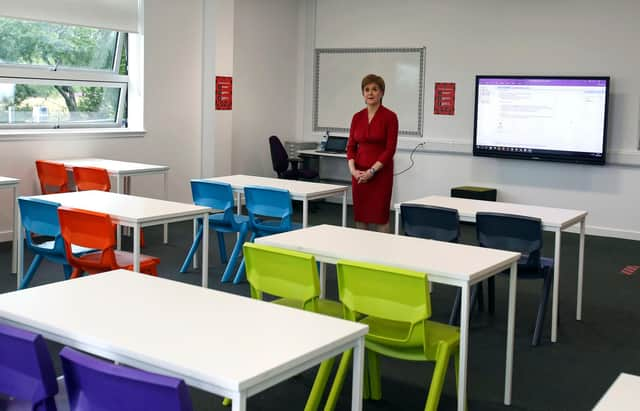Analysis: Covid-19 and schools approaching crunch point for Nicola Sturgeon


But that commitment is approaching its toughest challenge as 2021 barrels towards us without any sign of an imminent let up from the ongoing battle against Covid-19.
The situation for the Scottish Government is far from simple. Just yesterday Nicola Sturgeon stood up in front of the Scottish Parliament and announced the expected imposition of level four lockdown restrictions on much of the Central Belt.
Advertisement
Hide AdAdvertisement
Hide AdAnd yet, schools remain open after lobbying from parent groups and opposition politicians forced the decision to fully open them in August.
That decision, which had never been the Government’s preferred choice (remember blended learning?) remains the policy.
But with 30,000 pupils off from school last week, mostly due to requirements to self-isolate, that decision is not without its political disadvantages.
The scientific evidence on in-school transmission is uncertain. We know young people do not spread the virus at a rapid rate and less so than adults, and there is little evidence schools being open radically increases the rate at which the Covid-19 spreads.
However, concerns around infectiousness of older teenagers are serious enough to have forced the Government to usher in new mandatory face covering rules for older pupils three weeks ago.
And the number of staff off due to the impact of Covid-19 is also showing an upwards trend.
A total of 630 staff were off with confirmed Covid-19 or showing symptoms on November 10, with nearly 2,000 staff off for other Covid-19 reasons, up by around 150 and 500 from October 20.
Those statistics, in a briefing paper by the Covid-19 Advisory Sub-Group on Education published today, sit alongside modelling that states closing schools would have a “moderate impact” on the R number, but less than other measures, with transmission of Covid-19 most common between staff.
Advertisement
Hide AdAdvertisement
Hide AdThis week, Larry Flanagan, general secretary of Scotland’s biggest education union the EIS, told the BBC the union’s members were being asked whether they would consider striking over safety concerns, which some believe are being discarded to push what is politically preferable.
That perceived lack of support for teacher concerns means the temperature of the situation is starting to rise and is approaching boiling point.
It leads to an inevitable crunch point for the policy, especially if infection rates stay stubbornly high in Glasgow and its surrounding area.
For Ms Sturgeon, closure of schools is critical to avoid for any period of time.
Much of her Covid-19 policy - household visiting bans, closure of hospitality, travel restrictions – has been justified on the basis that schools will stay open throughout the pandemic while bringing transmission down.
Without more measures available and high infection rates, not closing schools could look irresponsible.
For education secretary John Swinney, rowing back on his Government’s long-standing commitment would also be the third catastrophic, and potentially unsurvivable, U-turn in the space of six months.
School strikes may force the First Minister’s hand, but in any case parents and pressure groups instrumental in pressuring the Scottish Government into the decision to abandon blending learning in the summer will not stay silent if schools shut.
Keeping schools open while driving down Covid-19 seems an almost impossible balance.
Comments
Want to join the conversation? Please or to comment on this article.
